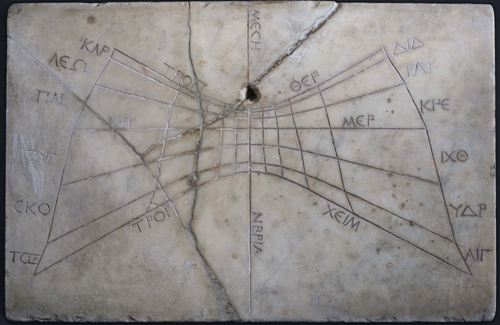
Horizontal Gnomonic Dial (Inv. 3075)
by permission
Museo Archeologico Nazionale di Napoli
|

Statuette of Atlas Bearing a Hemispherical Sundial
by permission
Sir John Soane's Museum, London
|
The Institute for the Study of the Ancient World (15 East 84th Street in New York) is hosting an exhibition "Time and Cosmos in Greco-Roman Antiquity" open to the public from now until April 23, 2017. From their on-line invitation, "This exhibition aims to explore the ways that time was organized and kept track of in the Greco-Roman world, and how it was conceived in relation to the Cosmos. The objects displayed include artifacts illustrating the technology of ancient time-reckoning and the perception, visualization, and social role of time and cosmos..." This is exemplified by a wonderful horizontal gnomonic sundial using a vertical gnomon shown at left. It was found at Pompeii around 1865 and became part of the Museo Archeologico Nazionale di Napoli in 1867. "Despite the fact that it was found in Italy, the inscriptions on it are in Greek, perfhaps reflecting the status of Greek as the langauage of science in antiquity. The summer and winter tropics (solstices), equinox, and seasons are reasonably declined. The hour lines however reflect temporal hours rather than the hour angles we would draw todayl.
"Time and Cosmos presents over 100 objects, including ancient sundials, calendars, jewelry, and surveying instruments, and is organized around two themes: the Tools of Time Reckoning, exploring the material resources that gave temporal structure to the daily life of private individuals as well as the community in such public spheres as religion, commerce, and law; and Reflections of Time and Cosmos, concerning ancient representations of time, the universe, and their power to shape the environment and human destiny." Perhaps a representitive of the universe is seen in figure of Atlas shown at right. First illustrated by Giuseppe Settele in 1816, it was found at Tor Paterno, the site of a Roman seaside estate not far from Rome. Settle says that by the time of his publication, it had entered an English collection. Recently this collection was identified as that of Sir John Soane's Museum. Parts of the sundial bowl were restored in the late 18th century and the figure was made by the addition of a wedge of stone below its base to tilt it so that it became a sundial showing equinoctial hours."
Read more at: http://isaw.nyu.edu/exhibitions/time-cosmos